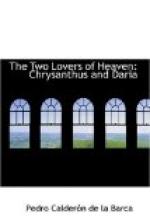“Taking for example, the great German authority on this point, Dr. Lorinzer [Lorinser], as our guide, we see his poet looming dimly through a cloud of incense, which may embalm his memory, but certainly does not improve our eyesight. Indeed, according to him, any appreciation of Calderon is not to be dreamt of by a Protestant”. Lectures, pp. 109, 110.
With every respect for Sir F. H. Doyle, Dr. Lorinser says no such thing. He was too well informed of what had been done in Germany on the same subject, before he himself undertook the formidable task of attempting a complete translation of all the Autos of Calderon, to have fallen into such an error. Cardinal Diepenbrock, Archbishop of Breslau, who, in his “Das Leben ein Traum” (an Auto quite distinct from the well known drama “La Vida es Sueno”) first commenced this interesting labour in Germany, was of course a Catholic. But Eichendorff and Braunfels, who both preceded Dr. Lorinser, were Protestants. Augustus Schlegel and Baron von Schack, who have written so profoundly and so truly on the Autos, are expressly referred to by Dr. Lorinser, and it is superfluous to say that they too were Protestants. Sir F. H. Doyle, in using my translation of the passage which will presently be quoted, changes the word ‘thoroughly’ into ‘properly’, as if it were a more correct rendering of the original. Unfortunately, however, there is nothing to represent either word in the German. Dr. Lorinser says, that by many, not by all, Calderon cannot be enjoyed as much as he deserves, because a great number of persons best competent to judge of his merits are deficient in the knowledge of Catholic faith and Catholic theology which for the understanding of Calderon is indispensible—“welche fuer Calderons Verstaendniss unerlaesslich ist”. Sir F. H. Doyle says that to him these Autos are not “incomprehensible at all” (p. 112), but then he understands them all the better for being a scholar and a churchman.
Sir F. H. Doyle thus continues his reference to Dr. Lorinser. “Even learned critics”, he says, “highly cultivated in all the niceties of aesthetics, are deficient in the knowledge of Catholic faith and Catholic theology properly to understand Calderon” (Lectures, p. 110, taken from the Introduction to my volume, p. 3). “Old traditions”, continues Dr. Lorinzer, “which twine round the dogma like a beautiful garland of legends, deeply profound thoughts expressed here and there by some of the Fathers of the Church, are made use of with such incredible skill and introduced so appositely at the right place, that . . . . frequently it is not easy to guess the source from whence they have been derived” (Lectures, p. 111, taken from the Introduction to my volume, p. 6).




